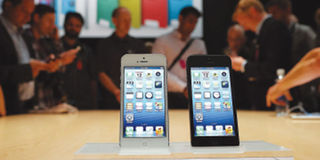Apple’s iPhone 5 faces stiff competition from rivals

PHOTO | AFP The new iPhone 5 is displayed during an Apple special event in San Francisco, California.
What you need to know:
- As Apple rides on the success of the iPhonel, rivals are refining their gadgets to beat the innovation behind iPhone and push their products to the top
- Some of the features of the iPhone 5 include a 4-inch retina display screen, ultra fast wireless connectivity and a dual core A6 processor chip
- When the operating system or software comes into play, the iPhone faces a plethora of Androids
The iPhone has established itself as the top selling brand in the smartphone world. Since its debut in 2007, the device remains Apple’s top selling product. Recently launched iPhone 5 sold two million units in first-day orders.
However, as the company rides on the success of this smartphone model, rivals are refining their gadgets to beat the innovation behind iPhone and push their products to the top.
Some of the features of the iPhone 5 include a 4-inch retina display screen, ultra fast wireless connectivity and a dual core A6 processor chip. Quite a number of features are already available on the iPhone 4S, thus making the new phone an upgrade of the former. The iPhone runs on IOS operating system.
When the operating system or software comes into play, the iPhone faces a plethora of Androids. Several device makers are tinkering with the latest versions of Android OS to entice users while giving the iPhone stiff competition in global markets.
Samsung, Sony, Motorola, and HTC all have new smartphones on their production lines. Samsung is working on another model of the Galaxy S after a bruising battle for supremacy with Apple.
By the end of July, it reported soaring sales of the Galaxy SIII, registering 10 million gadgets in under two months. The Galaxy SIII is considered a top runner in the Android race and a real threat to the iPhone dominance.
The Galaxy’s display screen is larger compared to the iPhone 5, and considerable number of features are at par. The size and quality of the display screen is one feature that rivals are exploiting to lure users.
Generally, the open source nature of Android software has paved way for more innovation and creativity with device makers churning out improved gadgets. Apple’s IOS is a closed system. Developers and device makers seem to be relishing every new freebie of Android while avoiding the restriction in closed systems.
Android OS is now the leading software in smartphones. Some of the features that have been showcased with the launch of the iPhone 5 are already available on a number of smart Android phones. An example is the Panorama tool found in the iPhone’s camera.
LG Electronics is also sending clear signals in its quest for the smartphone market share with a powerful Optimus G phone. The gadget was recently showcased in South Korea and New York City with promises of shipment to select markets by November.
The phone has a 4.7-inch high definition display powered by a quad-core processor. Apart from the big screen, it stands out with its combination of LTE super-fast connectivity and the Qualcomm’s Snapdragon S4 Pro Quad-core processor.
In the smartphone world, gadgets are being equipped with extra processing power just like in the computing scene. This design feature involving use of quad core chips is taking shape especially among competitors.
The new iPhone 5 does not sport a Quad core processor like its rivals. The gadget would sound inferior to competitors like Samsung Galaxy SIII, HTC One X, LG Optimus G and others which are powered by Quad core chips.
This is only if the phones exhibit the aspects of the powerful chips. The real benefits of the immense processing power which is portent in Quad core chips can only be seen in gadgets where the software has been optimised for the processors. There is also the issue of battery life in relation to increasing processor power.
Unsatisfactory battery life is a thorn in the flesh of Android-based smartphones compared to the iPhones. The battery drain becomes evident when multiple apps are running on the phone. Hopefully, chip makers like Nvidia are addressing the issue.
Samsung Galaxy S III has the Exynos Quad core chip that is touted to be power-efficient and able to process multiple complex computing tasks without compromising battery life.
Apples iPhone faces future competition from devices sporting Windows OS, pioneered by Microsoft and now being embraced by Nokia and other manufacturers. The latter recently launched the Lumia 920 smartphone, and HTC joined the race with a HTC Windows Phone 8X. The Nokia windows phones are sleek and the company is eying the iPhone’s dominance in its up-coming products.
The author is an ICT analyst and a telecommunication engineer.




